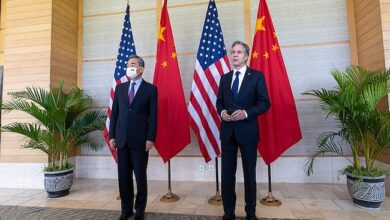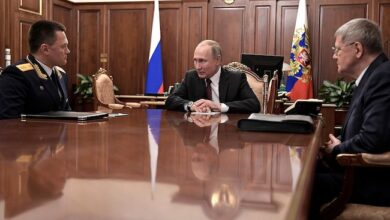
The global economy would be threatened by the emergence of neo-protectionist measures in the First World countries, particularly after Donald Trump’s recent signing of the executive order “Buy American, Hire American” as well as by the possible US withdrawal of the International Treaty signed by 195 countries in 2015 to reduce polluting emissions, known as the Paris Climate Agreement.
Towards neo-protectionism?
The return to the recurrent endemism of the Cold War between the US-Russia after the crisis in Ukraine and the imposition of sanctions by the EU-Japan-USA against Russia, would mark the beginning of the decline of the global economy and free trade, particularly since it was shown to be dysfunctional in Doha Round (organism whose main objective was to liberalise world trade through a major negotiation among the 153 member countries of the World Trade Organization (WTO) and have failed in all its attempts since its creation in 2011. Thus, we will see the termination of transnational trade agreements (TTIP, NAFTA and TTP) and the implementation of protectionist measures by the First World economies against emerging countries whose paradigm would be the establishment by the US of anti-dumping measures against steel and aluminium. through the imposition of tariffs of 25% and 10% respectively and that will mean the return to economic Neo-Protectionism.
Finally, both the EU and the US will implement the doctrine of the “Promotion of the Consumption of National Products” in the form of aid to avoid the relocation of companies, subsidies to the agri-food industry for the implementation of the BIO label to all its manufactured products, a raising of the Quality Parameters required of the products manufactured abroad and the imposition of additional phytosanitary measures on products from emerging countries. This will force China, Mexico, South Africa, Brazil and India to make quite expensive investments to reduce their pollution levels and improve quality parameters, setting up a five-year scenario in which they would go from commercial wars to economic protectionism, with the subsequent contraction of world trade, settlement of economic globalisation and return to a compartmentalised global economy.
The third wave of recession?
The latent risk of a “third wave of recession” caused by the imminent US-China trade war and the subsequent stock market detonation could cause economic stagnation to take over the world economy in the 2019-2020 biennium. Thus, China would be immersed in an economic identity crisis having to implement a wide range of structural reforms and among the fragilities of its economy is its still-limited international financial integration, its isolation and control of the state apparatus in the domestic sphere, as well as an inefficient allocation of economic resources caused by public paternalism and an insufficient level of creation of distribution, marketing and sales networks.
With regard to Latin America and the Caribbean, the contraction of world demand for commodities would already be causing the strangulation of their exports and the generalised depreciation of their currencies due to the strength of the dollar, which will translate into increases in production costs, loss of competitiveness, unbridled inflation rates and spectacular increases in foreign debt. Thus, according to the Managing Director of the IMF,Lagarde, “the strength of the dollar together with the weakness of the prices of the products creates risks for the balances and financing of the debtor countries in dollars”, from which it is deduced that the economies of Latin America and the Caribbean will be more exposed to a possible appreciation of the dollar and the reversal of associated capital flows, a phenomenon that could once again produce the “Lost Decade of Latin America” ( the 80s decade), aggravated by a notable increase in instability social, an increase in poverty rates and a severe retraction of democratic freedoms.
Is a new stock market crash ?
Our mind is capable of sequencing only fragments of the total sequence of the immense chaos genome, with which we inevitably resort to the term “butterfly effect” to try to explain the vertiginous conjunction of centripetal and centrifugal forces that will end up configuring the disconnected puzzle of ordered chaos that is brewing. Thus, the “butterfly effect” transferred to complex systems such as the Stock Exchange, would have the collateral effect of not being able to detect a mediated future in advance, since the quantum models they use would only be simulations based on previous models (Minsky’S Theory of Financial Instability), so that the inclusion of just one incorrect variable or the sudden appearance of an unexpected variable causes the margin of error of these models to be amplified in each unit of time simulated to exceed even the stratospheric limit of one hundred percent, resulting in a new stock market explosion or crash.
The current bubble would be born of the euphoria of Wall Street and by extrapolation from the rest of the world stock exchanges following the monetary policies of the great global Central Banks that have flooded the markets with hundreds of billions of dollars and Euros in the hope of re-floating the economy after the 2008 crisis, combined with the fact of zero returns in risk-free investors placements of US and German debt.
The disconnection from reality on the part of investors would lead them to justify the irrational exuberance of the markets, creating a virtual world of financial speculation that would have nothing to do with the real economy (windhandle) which leads them to extrapolate current yields as if they were a life-long right, which together with the loss of credibility of rating agencies such as Moody’s by not having predicted the 2002 crisis and the absence of control by regulators, would have contributed to a market remaining insensitive to lowering the rating of the companies quoted on stock-market, and also insensitive to the announcements of the Fed that, from mouth of its previous president Janet Ellen would have warned that “the valuations of the stock exchanges and the markets of bonds are very high and that potential risks exists in both markets.”
The markets’ irrational exuberance
The speculative process drives to buy in the hope of substantial profits in the future, which causes an upward spiral removed from any factual basis and the price of the asset reaching stratospheric levels until the bubble ends up bursting due to the massive share sell-off in the absence of buyers, which causes a sudden and abrupt fall of the prices until reaching levels lower than their natural level (crack), fulfilling once more the maxim of Keynes:”Markets can remain irrational longer than you can remain solvent”.
Thus, investors are willing to pay a price for a share if it earns money in the future, so the value of this share is the total of expected flows, but the floor level of the world stock exchanges, (level at which they converge) minimum profit and multipliers), would be light years away from current levels due to the risk of economic protectionism, but the real possibility of a new stock market crash would go unnoticed by most rating agencies due to the disconnection with the reality that it would lead them to justify the irrational exuberance of the markets and discard the hedge funds, which would fulfil the famous phrase of the iconoclast John Kenneth Galbraith. “There are two classes of economists: those who have no idea and those who do not even know that much”.
The coronavirus pandemic
Due to the “Trump effect”, US investors were euphoric after exceeding the Dow Jones’ iconic ceiling of 29,000 points, (recalling the stock market boom of the 20s, prelude to the stock market crash of 1929), so they were unable to perceive vertigo, however the high US deficit levels ($ 3 Trillion in 2020) and the risk of the coronavirus pandemic will cause large investors to feel the evil of vertigo for the first time, which in turn will lead them to reduce their exposure to risk with the consequent downward effect on stock prices and the revaluation of sovereign debt. Finally, the foreseeable rises in the dollar’s interest rate by the Fed in 2020 will force investors to distance themselves from equity assets and bearish ones at the helm of the world stock exchange rising, deriving in a selling psychosis that will end up causing the current stock market bubble to burst.
This will fulfil the iconoclast Galbraith´s maxim: “The day will come when the market will fall like it will never stop”.As a side effect, this collapse will cause the consequent financial starvation of companies, the subsequent devaluation of the currencies of countless countries to increase their exports and as beneficial effects, force companies to redefine strategies, adjust structures, restore their finances and restore their market credibility (as happened in the 2000-2002 stock market crisis) and as collateral damage the financial ruin of millions of small investors still dazzled by the lights of the stratosphere, the financial starvation of companies and the consequent domino effect in bankruptcy declarations.




